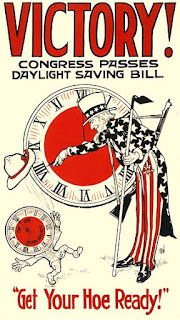Thursday, November 2, 2017
What time is it anyway?
Does the very idea of turning the clocks back every fall (and forward in the spring) make you fighting mad? Maybe that's why Daylight Savings Time was so popular during WWI and WWII.
Things could be worse. When New Zealand scientist George Vernon Hudson first presented a paper on the idea in 1895, he suggest turning the clock ahead TWO HOURS in March and back two hours in October. Imagine trying to adjust to that! Ten years later a British builder, William Willmett came up with an even more complicated plan: move the clocks up 20 minutes on each of four Sundays in April and back again on four Sundays in September.
The whole idea didn't really catch on until April 30, 1916, when Germany set their clocks ahead an hour to conserve coal during WWI. Not to be outdone by the enemy, the United Kingdom and France followed suit a few weeks later. I mean it could be really confusing for spies to leak the time of a bombing raid and the Red Baron shows up an hour early.
Daylight savings time went away after the war and then came back in WWII. It was used year-round. FDR called it War Time. Spring forward, fall back became the law of the land in 1966, although the dates vary a little over the years.
This year the time change coincides with a full moon, so your biological rhythm should be extra confused. When you find yourself with an extra hour on your hands this weekend, use it to download the Kindle version of Full Moon Friday. It's on a 99 cent special Saturday and Sunday. Celebrate the craziness.
Subscribe to:
Post Comments (Atom)


No comments:
Post a Comment